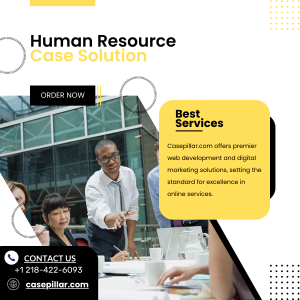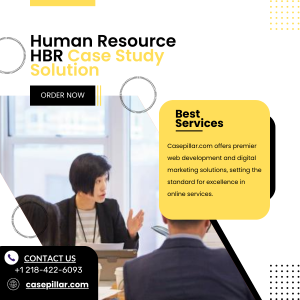Pay Someone To Take My Human Resource Case Study
Hire Someone To Take My Human Resource Case Study
Human resources case studies involve conducting in-depth analysis of simulated situations. They serve to develop critical-thinking and managerial acumen while helping students become acquainted with real world situations and strategies for dealing with complex problems. Understanding the Scope and Background Take some time to get familiar with the context of the HR case interview scenario you are tackling.

Ask detailed clarifying questions so you fully comprehend its key issues and players.
Identifying the Problem
Problem analysis is a method by which HR professionals assess current business situations and propose possible improvements, helping organizations address problems before they become too serious and impair performance. HR leaders use problem analysis as a means of identifying issues affecting employee morale or results – for instance they might study how change management impacts employee satisfaction levels.
An effective approach to problem analysis is conducting a literature review. This allows you to familiarize yourself with existing research on your topic, which you can incorporate into your case study. Involve yourself with ethical considerations and pilot testing if using interviews or surveys as these steps will ensure more accurate results and a well-rounded study. Recognizing the core problem will serve as the cornerstone of your entire strategy and solutions plan.
Identifying the Issues
One of the key components of an HR case study is clearly identifying its primary issue. This will serve as the cornerstone of your analysis and any recommendations made.
Delineating the scope of your analysis is also essential, helping keep your focus on the problem and avoid drift. From reducing employee turnover or increasing productivity to finding effective solutions for real-life global growth challenges such as developing strategies to manage international teams, navigating cultural differences and solving staffing problems, this case study will teach students how to successfully navigate real world global growth issues.
Identifying the Alternatives
There are various methods for analyzing Human Resource case studies. Some methods involve conducting a literature review and identifying potential solutions; other assessments focus on the impact of various factors affecting an organization’s HR issues; these factors could include organizational culture, workforce planning practices or recruitment practices.
Modern employment processes have become more intricate than ever, necessitating various skills and abilities for success. Human resource managers must have the ability to recognize key qualities or traits needed for specific jobs, while communicating these expectations to potential candidates.
HR managers need to understand how a candidate’s background impacts their success in the role, which includes assessing experience, educational background and professional development activities of applicants. HR managers should then be able to select an ideal candidate based on this criteria while being aware of ways they can assess technical knowledge and interpersonal skills of an applicant.
Writing the Case Study
Case studies are academic writing that examine simulated or real-life decision-making scenarios, particularly phenomena which cannot be studied using laboratory or quantitative methods. Case studies can help students to develop problem solving abilities as well as managerial and leadership capabilities.
Human Resource managers face many obstacles, from employee engagement to international growth. This will enable you to focus on the main issue while remaining on topic. Next you should decide upon analysis tools you will employ such as SWOT analyses, interviews or other forms of research methodologies. Finally it is imperative that relevant sources are cited according to professor requirements; this ensures your analysis remains scientifically sound.
Human Resource Case Solution
Human resource case studies provide students with an invaluable way to develop problem-solving abilities while also demonstrating their knowledge of HR best practices and processes.

The PESTEL framework can be an invaluable asset when analyzing an HR case, enabling you to consider all of the elements that contribute to an incident or circumstance.
Define the Problem
To successfully write a case study, it’s essential that you clearly outline the problem you want to solve and what solutions could exist for it. Doing this will enable you to focus on key aspects of the situation while uncovering possible solutions.
Definition is of great importance when undertaking any system improvement project, as this involves describing and benchmarking current performance of the system, understanding stakeholder needs and agreeing on core requirements for improvement.
As part of your research endeavor, it’s also essential that you select suitable analysis tools and methodologies. These might include interviews, surveys, questionnaires, focus groups or any other means of gathering data collection methods.
Gather Information
Gathering information is key to any HR professional conducting research or student taking a case study exam, regardless of your profession or discipline. Doing it right requires learning how to navigate vast quantities of data and extract meaningful insights; along with an understanding of any ethical considerations surrounding their use.
Step one in any case analysis involves collecting all available information about its issues. This may involve reviewing case materials and asking pertinent questions, as well as assessing any laws, regulations or policies which might impact human resource practices.
Analyze the Data
Once your research is complete, the next step should be analyzing your data. This step is essential in identifying issues and possible solutions while simultaneously considering multiple perspectives when conducting this analysis.
Your data collection tools could include interviews, surveys, questionnaires, focus groups or pilot groups. When selecting the ideal method for you, ensure it has been tested with an initial group before proceeding to use it in your case study.
Unleash your critical thinking abilities by coming up with potential solutions to an HR issue. Evaluate each potential solution against its merits to determine which will provide maximum benefit to the organization.
Develop a Solution
Writing an HR case study can be an excellent way to demonstrate your problem-solving capabilities, yet requires both creativity and time for completion. Writing such an informative and captivating paper requires practice.
Once you have analyzed your data, the next step should be developing solutions to address your issue. When doing this, be sure to carefully consider its feasibility, cost and potential impact; typically this part of a case study lasts the longest.
UKG Pro human resource software streamlines HR so employees can focus on what matters most: people. Discover how it can benefit your organization today.
Implement the Solution
Once a Solution has been identified, an implementation plan must be put in place. This may involve gathering resources, seeking budget approval and acquiring permissions. Your project Champion should provide support throughout this process.
While implementing your Solution, it is critical to gather feedback from stakeholders. This feedback can help determine whether or not the Solution is effective.
Implementation may also expose new Guiding Questions that require further study, which can provide an invaluable learning opportunity. By being proactive about addressing potential problems early, your solution is more likely to succeed and thus more likely to meet its intended objective.
Evaluate the Effectiveness
Recognizing and analyzing HR issues are an integral component of running any successful business. This involves evaluating their HR practices, performance measures and management techniques; in addition to helping formulate policies, programs and procedures.
Clarifying the objective and scope of your case study investigation is key to its success. Selecting suitable analysis questions and selecting suitable research tools are also instrumental to its success, along with paying close attention to any deadlines or submission instructions that your professor may have provided you.
Tell the Story
Human resources professionals can take advantage of creating an engaging case study to hone and display their problem-solving, analytical abilities, and strategic thinking skills as well as identify best practices and innovative solutions to HR issues.
At a case interview, it’s vital to fully grasp the situation at hand and pose pertinent questions that will allow you to extract crucial data. For example, if there’s evidence of declining employee morale and engagement levels, questions regarding its causes as well as potential solutions should be asked about.
Human Resource HBR Case Study Solution
Step one is identifying the problem. A case study should clearly outline this aspect so that your audience understands both its causes and effects on your company.

Internal Assessments
Internal assessments are developed and administered by subject teachers as part of continuous evaluation to reduce student preparation time for final exams and help teachers adapt their teaching methods based on student performance.
Internal evaluations offer additional advantages: they can be scheduled on an ongoing basis. This enables HR departments to quickly identify employees who may need reassigning or additional training; in addition, frequent assessments help keep an eye on progress made by employees over time.
Internal assessments provide students with more individualized and meaningful assessments than traditional written assignments such as the IB Extended Essay (EE). By understanding grading criteria and following best practices during assessments, students can make the most out of them to increase their chances of success and ultimately reach success with these exams. Furthermore, assessments can serve to motivate employees at work and help improve performance by motivating employees towards bettering themselves as professionals.
Employee Feedback
Employee feedback is a fundamental element of HR management. It allows managers to pinpoint areas for improvement and explore potential for growth and development; improve employee performance; foster company culture. Employees appreciate receiving regular, both positive and negative, feedback as it reinforces that their efforts matter and they are valued.
Feedback can be offered in several different forms – between managers and employees, teams or departments. Managers may provide direct reports with feedback while employees can offer it back on their supervisors. To be effective, feedback must focus on behaviors and their impacts as well as being delivered in a supportive manner that does not judge anyone involved.
Keep in mind that feedback should never be seen as criticism of an employee, but rather as an aid to help improve their behavior in the workplace. HR departments should ensure their feedback does not constitute discrimination or harm employee morale.
Company Surveys
HRM (Human Resource Management) is the practice of human resource management that influences firm performance by improving employee-related outcomes, such as organizational commitment, justice, citizenship behaviors and engagement. HRM also includes nonfinancial results like personality development and the ability to solve new problems.
Human resource departments face another significant challenge in dealing with labor unions, which are groups of employees who collaborate to negotiate contracts and enforce rights within their workplaces. Labor unions may organize strikes that disrupt businesses.
An effective business survey can help identify your company’s strengths, weaknesses and opportunities through conducting a SWOT analysis. This method gives an in-depth view of what success means for your business in its target market as well as prioritizing actions needed to reach objectives.
Employee Relations
This may involve creating a confidential hotline where employees can voice any of their issues or voice their concerns anonymously. Furthermore, policies must also conform with current labor regulations.
An additional challenge faced by the department is dealing with labor unions. When management decides to lay off an employee due to lack of work, unions often rally to defend them and attempt to save them, potentially impacting production and missing customer deadlines.